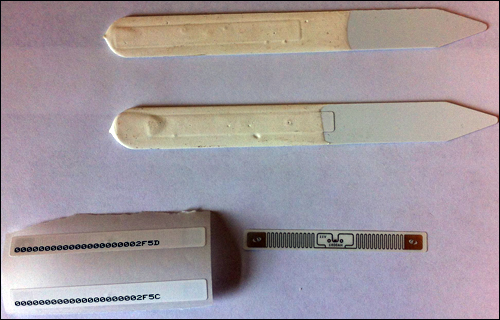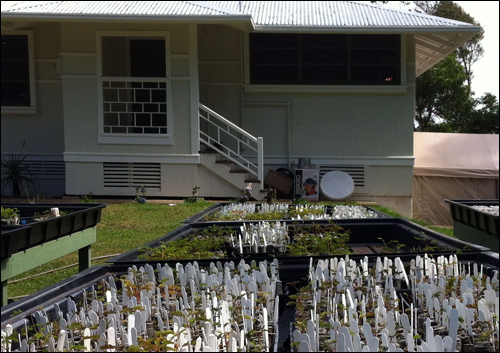For the past four years, Hawaiian Legacy Hardwoods (HLH) has been planting koa and other indigenous species of trees on former pastureland located on Hawaii Island (the Big Island). The company operates a for-profit division that plants trees for harvest, while its nonprofit division, LegacyTrees.org, plants koa trees for the purpose of permanent reforestation. Investment trees are sold in lots of 100, at a one-time cost of $9,380, for the 2013-14 planting season. The nonprofit division allows an individual to sponsor what HLH calls a “legacy tree,” often in memory of a loved one, for the price of $60, of which $20 goes to a charity of the customer’s choice, with $1 donated to the Hawaiian Islands Land Trust.
Central to the company’s operation is an RFID and GPS technology solution that makes it possible to identify every tree as it grows from a seedling at a nursery to a tree in the forest. Initially, the system was designed to uniquely identify each tree via a passive ultrahigh-frequency (UHF) RFID tag, with users employing handheld readers to interrogate those tags as the trees were planted, and again 25 year later during harvesting (see RFID Helps Foresters Grow Koa Trees). However, to support the reforestation activity’s expansion, the RFID system needed to be revamped in order to be able to track the large volume of trees that customers want planted and cultivated for a permanent forest.
To date, Hawaiian Legacy Hardwoods has dedicated approximately 1,000 acres of land to reforestation efforts on the slopes of Mauna Kea, an inactive volcano. However, the company is currently negotiating for the purchase of sufficient acreage to increase that size many times over. Most of the firm’s growth has been in the realm of legacy forest tree planting, in which individuals purchase a seedling to be planted permanently and cared for within the dedicated forest.
William Gilliam, HLH’s chief information officer, says that some new features have already been incorporated into its RFID-based tracking system, while others are still in the works, to be implemented later this year or in 2014.
For instance, Gilliam says, the company recently began printing and encoding its own EPC Gen 2 passive RFID tags to keep up with demand. When HLH first launched its operations, it required about 40,000 tags annually. But more recently, the firm has needed 120,000 tags for a single planting season. To address this tag volume, the company acquired an RFID printing-encoding solution, supplied by SimplyRFID, featuring a Zebra Technologies R110Xi4 printer-encoder to generate labels more quickly.
In the past, Hawaiian Legacy Hardwoods tracked the locations of trees by collecting data from GPS units mounted on posts at the four corners of 100-tree blocks. The company now plans to obtain a specific GPS location for every planted tree. To accomplish this goal, HLH has designed its own handheld RFID readers that will capture a particular tree’s GPS location at the same time that it reads the tag ID number of the tree being planted. That same handheld (which the firm is now testing in its prototype stage) can be used during maintenance work, such as fertilizing or watering the trees. A user would simply input which chores were taking place, and the interrogator would read the tag and link that tree with the tasks being carried out, along with a time and data stamp.
In fact, Gilliam says, HLH also intends to install a camera on the handheld, in order to make it possible for staff members to take photographs of the trees while carrying out their maintenance work. Those photos and related maintenance data would then be stored in the server software, linked to the tag ID numbers.

During the coming year, Gilliam also envisions adding passive EPC Gen 2 tags to staff badges, as well as to equipment and tools. The company could then track which personnel provided services in which areas, such as watering or removing other encroaching plant growth within a specific zone. It could also locate equipment more quickly when necessary, or track when a fence was repaired, based on the reading of a tag posted on that fence.
New software being developed by Gilliam will allow individual tree owners to locate a particular tree, based on its RFID number, on an image similar to those found on Google Earth. The company uses the Google Earth application as a visual demonstration tool for guests. However, the firm is developing a proprietary system that will employ an open-source online mapping platform to generate imagery onto which each tree’s location data can be displayed. That service is expected to be made available via HLH’s Web site in 2014.
When purchasing a legacy tree seedling, an individual provides the details that he or she would like to store with that tree’s ID on HLH’s server, such as the name of a person to which the tree is dedicated, as well as details regarding that dedication. The customer then receives a certificate that includes the tree’s details, including the unique ID of the tag that will remain with the tree throughout its life. That tag is then placed in the soil alongside the seedling.
The tags are encoded on a Zebra R110Xi4 printer, and each 3-inch tag is then attached to a stake and dipped into a plastic sealant, to ensure that the tag is protected from the environment. The ID number printed on the front of the Confidex Carrier tag matches the one encoded to the tag’s RFID chip, but it is covered by the plastic sealant.
The unique ID number is also entered into HLH’s management system, linked to information about the tree itself, such as its “mother tree,” as well as the data provided by the customer. Until now, tags were read only when a sapling was planted, as well as at any time that a tree’s identity needed to be confirmed. During the coming months, however, workers will be equipped with the handheld reader developed by HLH, and all services provided to a particular tree can then be linked to its ID number for reference purposes—both for HLH’s staff and for the customer, who can log onto the HLH site and track the tree’s progress.
For example, the trees are periodically measured for growth, and that growth data is entered into the system. Every time the tree is fertilized or watered, that information is input as well, and the plants’ GPS-based location is also stored with the RFID number
If visitors arrive to see their trees, the company can loan them a handheld reader. Since the forested trees are not laid out in a grid of rows, they can be difficult to identify. According to Gilliam, the RFID technology is the only way in which many of the trees could be properly identified as the years pass.
The company is presently in discussions with other landowners who would like to launch their own legacy forest in other parts of the world. In this case, says Jeffrey Dunster, Hawaiian Legacy Hardwoods’ CEO, the company could provide consulting services, along with the RFID solution that it has developed to enable the tracking of each tree.



